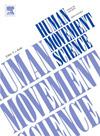Optic flow and cycling effort: Where to look to go faster
IF 1.9
3区 心理学
Q4 NEUROSCIENCES
引用次数: 0
Abstract
Optic flow can significantly influence the perception and exertion of effort. In this study, we investigated the effects of exposure to proximal and distal areas of the optic flow field on exerted and perceived cycling effort. Thirty cyclists participated in two 20-min cycling trials within a virtual reality environment, with the goal of surpassing the power output achieved during a baseline trial. During these trials, they viewed the environment through a proximal or distal window, in counterbalanced order. We measured the cyclists' exerted effort on a bicycle trainer, and recorded their responses regarding perceived effort and psychological momentum experience. A one-way repeated measures ANCOVA with average baseline power as a covariate revealed a significant difference in exerted effort between the proximal and distal condition, with higher average exerted effort in the proximal condition. However, a significant interaction effect between condition and baseline power indicated that the beneficial effect of the proximal condition was mainly present for lower-level cyclists. We observed no significant differences in perceived effort or psychological momentum. These findings provide novel insights into the relation between optic flow and cycling effort, and call for new research on the mechanisms underlying this relation.
光流和循环努力:哪里看得更快
光流可以显著影响努力的感知和发挥。在这项研究中,我们研究了暴露于光流场的近端和远端区域对施加和感知的循环努力的影响。30名骑行者在虚拟现实环境中参加了两次20分钟的骑行试验,目标是超过基线试验期间实现的功率输出。在这些试验中,他们以平衡的顺序通过近端或远端窗口观察环境。我们测量了骑自行车者在自行车训练器上施加的努力,并记录了他们对感知努力和心理动力体验的反应。以平均基线功率为协变量的单向重复测量ANCOVA显示,近端和远端条件下的用力有显著差异,近端条件下的平均用力更高。然而,条件与基线功率之间存在显著的交互作用,表明近端条件的有利作用主要存在于水平较低的自行车运动员身上。我们观察到在感知努力和心理动力方面没有显著差异。这些发现为光流与循环努力之间的关系提供了新的见解,并呼吁对这种关系的机制进行新的研究。
本文章由计算机程序翻译,如有差异,请以英文原文为准。
求助全文
约1分钟内获得全文
求助全文
来源期刊

Human Movement Science
医学-神经科学
CiteScore
3.80
自引率
4.80%
发文量
89
审稿时长
42 days
期刊介绍:
Human Movement Science provides a medium for publishing disciplinary and multidisciplinary studies on human movement. It brings together psychological, biomechanical and neurophysiological research on the control, organization and learning of human movement, including the perceptual support of movement. The overarching goal of the journal is to publish articles that help advance theoretical understanding of the control and organization of human movement, as well as changes therein as a function of development, learning and rehabilitation. The nature of the research reported may vary from fundamental theoretical or empirical studies to more applied studies in the fields of, for example, sport, dance and rehabilitation with the proviso that all studies have a distinct theoretical bearing. Also, reviews and meta-studies advancing the understanding of human movement are welcome.
These aims and scope imply that purely descriptive studies are not acceptable, while methodological articles are only acceptable if the methodology in question opens up new vistas in understanding the control and organization of human movement. The same holds for articles on exercise physiology, which in general are not supported, unless they speak to the control and organization of human movement. In general, it is required that the theoretical message of articles published in Human Movement Science is, to a certain extent, innovative and not dismissible as just "more of the same."
 求助内容:
求助内容: 应助结果提醒方式:
应助结果提醒方式:


